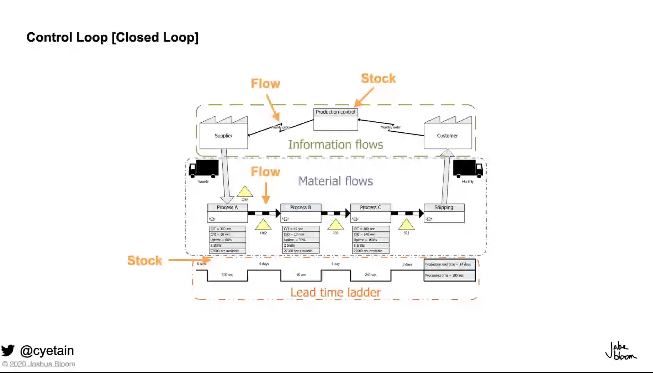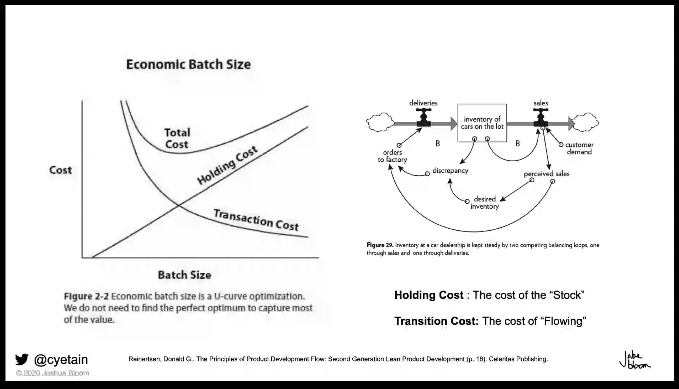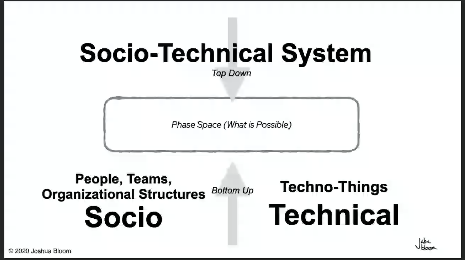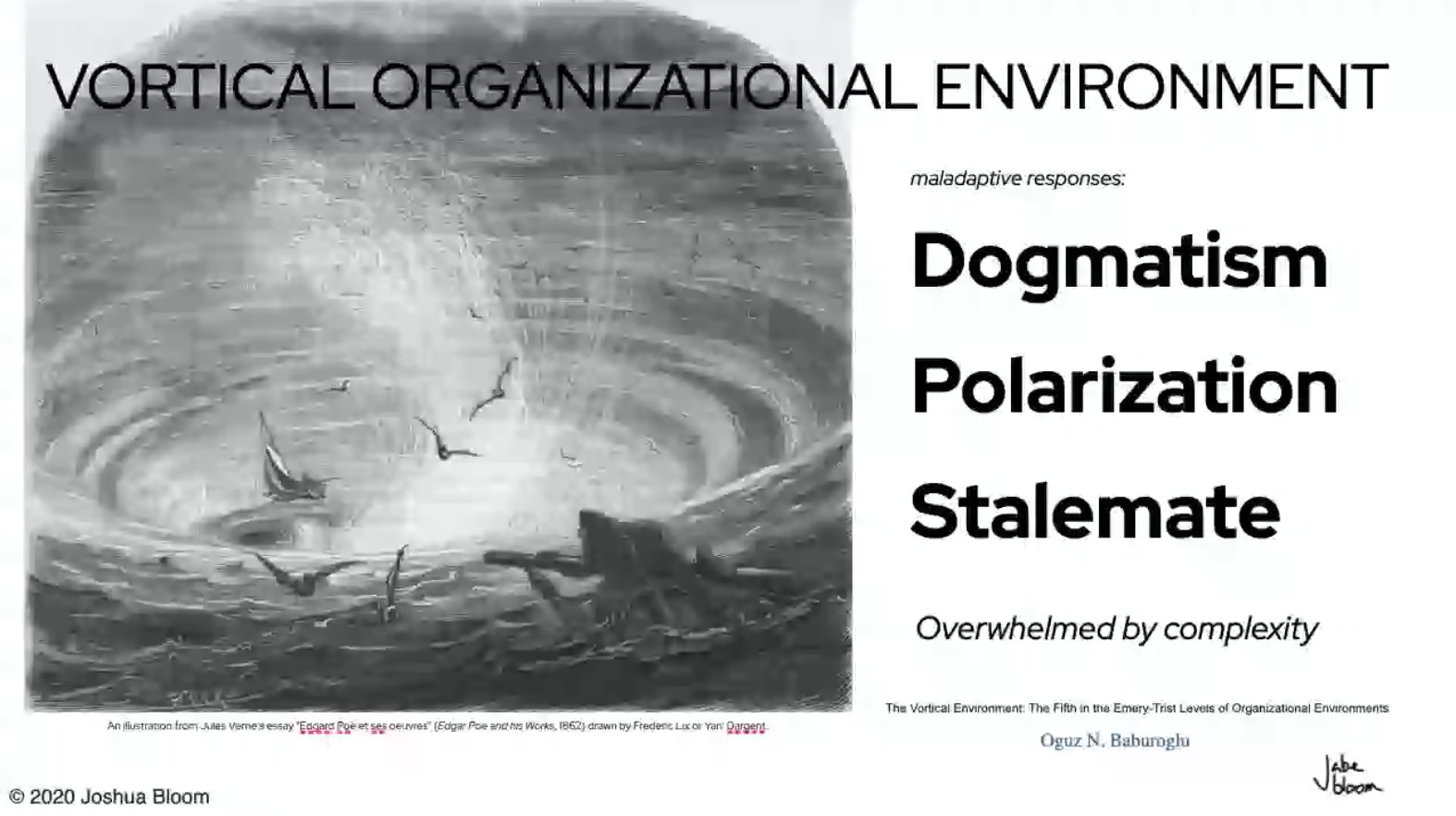Thinking about flow from some new perspectives. Find opportunities to think about flow. Talk about turbulence: how flow is both good and bad.
Summarising Twitter threads about the talk:
What is Normal?
The track is called new normal. Normal is kind of a weird idea.
Difference between complexity and unnecessary complexity. Certain type of complexity is natural and certain are not.
When we try to create a flow system is we try to keep that system inside certain tolerances.
Standard deviation => bell curve => control
Do not confuse variation and variety when creating a #flow system : we want to induce variety and limit variations #flowcon
– Anne Gabrillagues (@agabrillagues), Nov 2, 2020
Variation: the unintended creation of difference in output Flow => reduce this of kind of change
Variety: the intentional creation of difference in outcome variety is not a bad thing, it is a good thing => Toyota system
The relation between the two is what we want to achieve in a Flow system
Toyota: 1 flow line but a variety of car models to produce
=> intend of Flow system: In control of a stable quality output
How is normal related to Flow?
What is Flow?
Different definitions of Flow:
Flow: Material or information that enters or leaves a stock over a period of time
– Donella H. Meadows
The mark of a person who is in control of consciousness is the ability to focus attention at will, to be oblivious to distractions, to concentrate for as long as it takes to achieve a goal, and not longer. And the person who can do this usually enjoys the normal course of everyday life.
– Mihaly Csikszentmihalyi
Be like water making its way through cracks. Do not be assertive, but adjust to the object, and you shall find a way around or through it. If nothing within you stays rigid, outward things will disclose themselves.
Empty your mind, be formless. Shapeless, like water. If you put water into a cup, it become the cup. You put water into a bottle and it becomes the bottle. You put it in a teapot, it becomes the teapot. Now, water can flow or it can crash. Be water, my friend.
– Bruce Lee
It is not only physical flow, it is also information.
When we look at a transitional value stream map we see these flows.
A flow-based process delivers information on a regular cadence in small batches.
– Don Reinertsen
=> close the loop, removing cycle time from the loop

Holding Cost: the cost of the “Stock” or the cost of withholding information
Transition Cost: the cost of “Flowing” or the cost of moving the information from one point to another point
=> shift the total cost to the left by allowing to move the information out of the holding base

Another important point of the #flow thinking is to understand what the system should be doing - #flowcon
– Anne Gabrillagues (@agabrillagues), Nov 2, 2020
If we are examining a particular device designed by the engineer to perform specific tasks under a rather narrow range of predictable external conditions, we are likely to be more concerned with consistent nonvariable performance in which slight departures from the performance goal are immediately counteracted.
– CS Holling
Some different ways of thinking
How are Hierarchy and Stability related?
#complexity starts when a system begins to be dependant on itself, or on its parts - #flowcon
– Anne Gabrillagues (@agabrillagues), Nov 2, 2020
context-sensitive constraints … take a system far from independence. Complexity happens when previously independent entities or events interact or are otherwise correlated. Catalysts are examples of context-sensitive constraints; given their presence, other things become more likely. Feedback loops do the same: when present they change the probability landscape of subsequent events.
– Alicia Juarrero
Systems are about Relationships
- part vs whole: bottom up relationship
- whole vs part: top down relationship
- whole part vs whole part: peerwise relationship
I’m a person, I’m a whole person. But I am also a member of Redhat which makes me a part of another whole system.
self-organization first requires the closed loop of feedback and catalytic processes, but once constraint closure takes place and the systemic network emerges, mereological recursion then loops between levels, between components and coherent whole.
– Alicia Juarrero
About the specific role of constraints in a #flow system - #flowcon
– Anne Gabrillagues (@agabrillagues), Nov 2, 2020
Whole-to-part or top down constraints … are restrictive; no longer independent and isolated particles become components of a coherent unity and are thus restricted so as to not only maintain but (re)generate the whole. Part-to-whole (bottom up) constraints are enabling; when they close the very phase space expands.
– Alicia Juarrero
=> we can now see a kind of Hierarchy, a layering of sub-systems: part being part of a whole which in turn is part of another whole

The rising of socio technical systems in the #flow thinking - #flowcon – Anne Gabrillagues (@agabrillagues), Nov 2, 2020
2 aspects to a system: human and technical aspect => Socio-Technical System
Socio: people, teams, organizational structures
Techno: technical
we are moving away from an HCI/Ergonomics system to a Social interactions mediated by Technology
The view is changing from observation of the flow of materials through a system to the flow of information created by the interactions in the system. @cyetain at #FlowCon – Marc Burgauer (@somesheep), Nov 2, 2020
=> we are not moving information from one place to another, we are creating information by interacting between people
In a #flow system we are not moving information from a person to another, we are creating new information using the interactions between people #flowcon – Anne Gabrillagues (@agabrillagues), Nov 2, 2020
… it is not possible to define the conditions under which an open system achieves a steady state unless the “system constants” include mediating boundary conditions. …
=> SocioTechnical Architecture
the reason why we allow for 6-sigma is that all systems are in constant failure => Continuous Partial Failure
it is the humans that re-establish flow through reconnection of systems => Skillful Coping
Resilience is irrevocably entwined with “Skillful Coping” … this coping … in order to “enable the performance” of the system, can result in a sense of learned helplessness.
My very ability to cope, negatively impacts the likelihood of change.
Coping can be bad and good #flowcon
– Anne Gabrillagues (@agabrillagues), Nov 2, 2020
By removing wastes we are not making the system more efficient, we are making the system able to better respond to change in the future #flowSystem #flowcon
– Anne Gabrillagues (@agabrillagues), Nov 2, 2020
Because the system is constantly fluctuating, we develop the capability of skilfully coping with unexpected outcomes of the fluctuation. By reducing such toil via improving the system, we make the system more capable of coping with the unexpected. @cyetain at #FlowCon – Marc Burgauer (@somesheep), Nov 2, 2020
“My very ability to cope negatively impacts the likelihood of change” #flowSystem #flowcon – Anne Gabrillagues (@agabrillagues), Nov 2, 2020
Complexity
All this stuff has clearly something to do with Complexity
Systems Theory: Systems tend to move towards certain types of complexity. And they don’t have a lot of options regarding this.
as an organisation, but also as a team
at its smallest sizes teams can react to this
Observe the environment as a way to discover the value. There is good hunting grounds for the teams, starting with the strategy - #flowcon
– Anne Gabrillagues (@agabrillagues), Nov 2, 2020
And of course your teams need to know how to hunt ! Your competitors actions are changing your hunting grounds, and instead of competing so yuor organization should move to a shared purpose relationship with competitors. #flowcon – Anne Gabrillagues (@agabrillagues), Nov 2, 2020

Continuous transition makes a system more resilient. The system must be stable and flexible enough. The balance plays itself out in time. #flowcon
– Sara Dufour (@ComSaraDufour), Nov 2, 2020
The “open systems” concept logically implies systems that spontaneously reorganize towards states of greater heterogeneity and complexity and achieve a “steady state” at a level where they can still do work.
– Fred Emery
Transformation invariably involves a state of transition, even multiple transformations and transitions. Turbulence places constituent system in continuous, permanent state of transition. This notion of continuous transition was also proposed by Schön (1971), who coined the term “the loss of the stable state”.
– Fred Emery
The system must be stable enough not to be buffeted around by every fluctuation, and it must be flexible enough to be able to adapt when necessary… The balance between stability and change is a contingent thing which plays itself out in time. What one can say, though, is that merely to be fast will destroy the system.
– Paul Cilliers
Emergent Constraints
when and how stocks are released?
a constraint could be a machine, a policy, information, in The Phoenix project it is Brent
the reason we do continuous integration is because the longer we wait to integrate the bigger the holding cost becomes of the sub system that is not yet integrated
=> this results in releasing a big chunk of information at once
=> the system is not designed to cope with that amount of information
=> 3 kinds of cost:
- the cost of the risk of integration
- the cost of doing the integration
- the cost of the duration to fix the integration
When we see a system perform above their ability to ingest information, we will observe a vortical organisational environment. We should not try to reduce complexity, but enable the system to cope with more complexity. @cyetain at #FlowCon
– Marc Burgauer (@somesheep), Nov 2, 2020
These are certainly not the right answers to #change.
#flowcon
– Sara Dufour (@ComSaraDufour), Nov 2, 2020
Vortical Organizational Environment
- dogmatisme: only one way to do it and it is my way
- polarization:
- stalemate: because people have different ways to see the world, they can not integrate with each other
=> overwhelmed by complexity

When an organization tries to ingest too much complexity at once
=> two forces: disintegration and delamination
Conclusion
We should not talk about New Normal but about New Normals
We are not looking for Equilibrium but for Equilibria
Existence is not an individual affair.
– Karen Barad
it is a group sport.
Interactions.
With your team, organisation, others.
“This is how meaning arises.” @cyetain #FlowCon #management #collaboration #change #TransfoNum
– Sara Dufour (@ComSaraDufour), Nov 2, 2020
Questions
How do you design SocioArchitecture?
Architecture is not what an architect does, it is something that a system does.
If you’re an architect working by yourself on your ivory tower, then you’re not doing architecture.
Architecture is a set of skills that need to be embraced by software engineers, ops engineers, product managers, … All of these people need to understand the consequences in order for architecture to arise.
Architecture is about policies and interactions and not about technology.